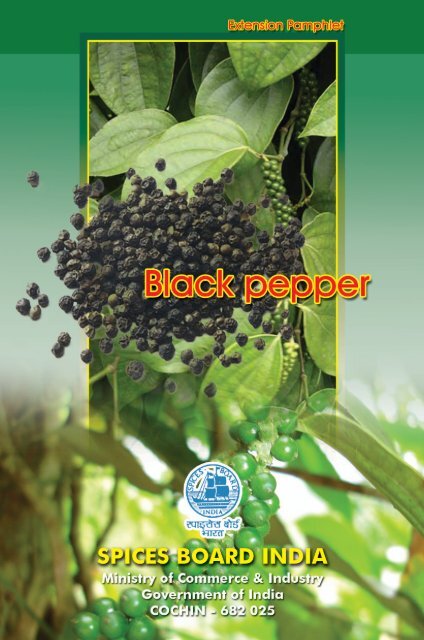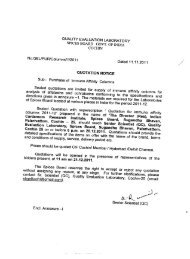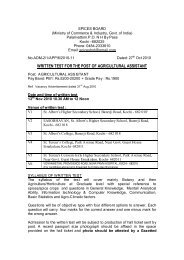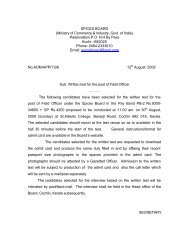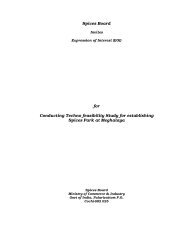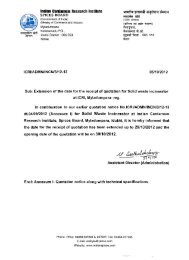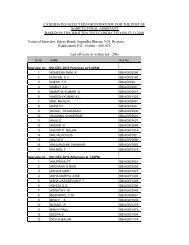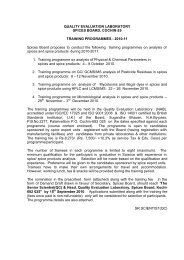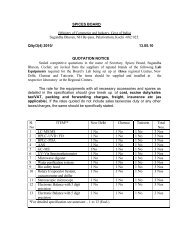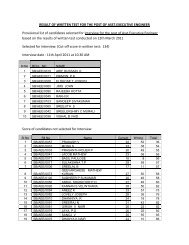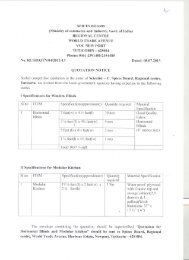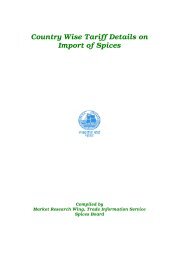Book-Black Pepper POP.pmd - Spices Board India
Book-Black Pepper POP.pmd - Spices Board India
Book-Black Pepper POP.pmd - Spices Board India
You also want an ePaper? Increase the reach of your titles
YUMPU automatically turns print PDFs into web optimized ePapers that Google loves.
<strong>Black</strong> pepper<br />
(Extension Pamphlet)
<strong>Black</strong> pepper<br />
(Extension Pamphlet)<br />
BLACK PEPPER<br />
Contributors<br />
Sasikumar B., Thankamani C.K., Srinivasan V.,<br />
Devasahayam S., Santhosh J. Eapen, Kumar A.<br />
and John Zacharaiah T.<br />
Editors<br />
Thankamani C. K., Srinivasan V., Dinesh R.,<br />
Santhosh J. Eapen, Rajeev P.<br />
Publisher<br />
V. A. Parthasarathy<br />
Director<br />
<strong>India</strong>n Institute of <strong>Spices</strong> Research<br />
Calicut<br />
Re-published by<br />
<strong>Spices</strong> <strong>Board</strong><br />
Ministry of Commerce & Industry<br />
Government of <strong>India</strong><br />
Cochin – 682 025<br />
Copies - 8000<br />
February 2009<br />
Printed at<br />
Niseema Printers & Publishers, Kochi - 18<br />
2
BLACK PEPPER<br />
<strong>Black</strong> pepper (Piper nigrum) (Family: Piperaceae) is a perennial<br />
climbing vine grown for its berries extensively used as spice and in<br />
medicine. <strong>India</strong> is a leading producer, consumer and exporter of<br />
black pepper in the world. During 2005-06, 17,563 tonnes of black<br />
pepper products worth Rs. 15,095 lakhs were exported to various<br />
countries accounting for 6.0 per cent of export earnings among<br />
spices. <strong>Black</strong> pepper is cultivated to a large extent in Kerala and<br />
Karnataka and to a limited extent in Tamil Nadu and other states.<br />
The crop is grown in about 2,46,000 hectares with a production of<br />
69,000 tonnes annually. Kerala and Karnataka account for a major<br />
portion (92 per cent) of production of black pepper in the country.<br />
Climate and soil<br />
<strong>Black</strong> pepper is a plant of humid tropics requiring adequate rainfall<br />
and humidity. The hot and humid climate of sub mountainous tracts<br />
of Western Ghats is ideal for its cultivation. It grows successfully<br />
between 20∞ North and South latitude, and from sea level up to<br />
1500 meters above sea level. The crop tolerates temperatures<br />
between 10o and 40∞ C. A well distributed annual rainfall of 125-200<br />
cm is considered ideal for black pepper. <strong>Black</strong> pepper can be grown<br />
in a wide range of soils with a pH of 4.5 to 6.5, though in its natural<br />
habitat it thrives well in red laterite soils.<br />
The black pepper growing areas in the West Coast of <strong>India</strong> include<br />
(i) coastal areas where black pepper is grown in homesteads (ii)<br />
midlands and where black pepper is extensively cultivated on a<br />
plantation scale and (iii) hills at an elevation of 800-1500 m above<br />
sea level, where the crop is mostly grown on shade trees in coffee,<br />
cardamom and tea plantations.<br />
Varieties<br />
A majority of the cultivated types are monoecious (male and female<br />
flowers found in the same spike) though variation in sex expression<br />
ranging from complete male to complete female is found. Over 75<br />
cultivars of black pepper are being cultivated in <strong>India</strong>. Karimunda is<br />
the most popular of all cultivars in Kerala. The other important cultivars<br />
are Kottanadan (South Kerala), Narayakodi (Central Kerala),<br />
Aimpiriyan (Wynad), Neelamundi (Idukki), Kuthiravally (Kozhikode<br />
and Idukki), Balancotta, Kalluvally (North Kerala), Malligesara and<br />
Uddagare (Karnataka). Kuthiravally and Balancotta exhibit alternate<br />
3
BLACK PEPPER<br />
bearing habit. A few important cultivars and their salient features are<br />
given in Table 1. In terms of quality, Kottanadan has the highest oleoresin<br />
(17.8 per cent) content followed by Aimpiriyan (15.7 per cent).<br />
Sixteen improved varieties of black pepper have been released<br />
for cultivation (Table 2). Panniyur-1 and Panniyur-3 are hybrids<br />
evolved at the <strong>Pepper</strong> Research Station, Panniyur (Kerala) and have<br />
Uthirankotta and Cheriyakaniakadan as their female and male<br />
parents, respectively. IISR Girimunda and IISR Malabar Excel are<br />
the two hybrids released from <strong>India</strong>n Institute of <strong>Spices</strong> Research,<br />
Calicut.<br />
Table1. Important cultivars of black pepper and their characteristic<br />
features<br />
Cultivar Fresh Quality attributes Features<br />
mean Oleoresin Piperine Essential Dry<br />
yield recovery<br />
(kg/vine) (%) (%) oil (%) (%)<br />
Aimpirian 4-5 15.0 4.7 2.6 34 Good for higher<br />
elevations, good in<br />
quality, late maturing<br />
Arakulan munda 2 9.8 4.4 4.7 33 Moderate and regular<br />
bearer<br />
Balankotta 1-2 9.3 4.2 5.1 35 Moderate and<br />
irregular bearing<br />
Karimunda 2-3 11.0 4.4 4.0 35 Suitable for all pepper<br />
growing areas, high<br />
yielder, shade<br />
tolerant.<br />
Kalluvally 1-2 8.4-11.8 2.5-5.4 3.0 35-38 Good yielder with<br />
high dry recovery,<br />
drought tolerant<br />
Kottanadan 5 17.8 6.6 2.5 34-35 High yielding, drought<br />
tolerant<br />
Kuthiravally 3 15.0 6.0 4.5 35 High yield, good<br />
quality<br />
Narayakodi 1-2 11.0 5.4 4.0 36 Moderate yielder with<br />
medium quality<br />
Neelamundi 2 13.9 4.6 3.3 33-34 Good yielder,<br />
Tolerant to<br />
Phytophthora<br />
infection<br />
Vadakkan 3 10.8 4.2 3.2 - Medium quality and<br />
yield<br />
4
Table 2. Improved varieties of black pepper and their characteristic features<br />
BLACK PEPPER<br />
Variety Pedigree Mean Dry Quality attributes Features<br />
yield recovery Piperine Oleoresin Essential<br />
(dry) (%) (%) (%) oil (%)<br />
(kg/ha)<br />
Panniyur -1(KAU) Hybrid between Uthirankotta x 1242 35.3 5.3 11.8 3.5 Not suited<br />
Cheriyakaniakadan to heavily<br />
shaded areas<br />
Panniyur -2 (KAU) Selection (Cul. 141) from cv. 2570 35.7 6.6 10.9 - Shade tolerant<br />
Balancotta<br />
Panniyur -3 (KAU) (KAU) Hybrid (Cul. 331)<br />
Uthirankotta x Cheriyakaniakadan 1953 27.8 5.2 12.7 - Late maturing<br />
Panniyur -4 (KAU) Selection from Kuthiravally Type 1277 34.7 - 9.2 - Stable yielder<br />
Panniyur -5 (KAU) Open pollinated progeny 1098 - 5.5 12.3 3.8 Tolerant to<br />
selection from Perumkodi shade<br />
Panniyur -6 (KAU) Clonal selection from Karimunda 2127 32.9 4.9 8.3 1.3 Suited to all<br />
black pepper<br />
tracts<br />
Panniyur -7 (KAU) Open pollinated progeny selection 1410 33.6 5.6 10.6 1.5 Suited to all<br />
from Kuthiravally black pepper<br />
tracts<br />
Subhakara (IISR) Selection from Karimunda (KS-27) 2352 35.5 3.4 12.4 6.0 Suited to all<br />
black pepper<br />
tracts<br />
Sreekara (IISR) Selection from Karimunda (KS-14) 2677 35.0 5.3 13.0 7.0 Suited to all<br />
black pepper<br />
tracts<br />
5
BLACK PEPPER<br />
Panchami (IISR) Selection from Aimpiriyan (Coll. 856)2828 34.0 4.7 12.5 3.4 Late maturing<br />
Pournami (IISR) Selection from Ottaplackal (Coll. 812)2333 31.0 4.1 13.8 3.4 Tolerant to root<br />
knot nematode<br />
PLD -2 (IISR, Clonal selection from Kottanadan 2475 - 3.3 15.5 3.5 Suited to<br />
CPCRI, Palode) Thiruvananthapuram<br />
and Kollam<br />
districts of<br />
Kerala<br />
IISR Shakthi Open pollinated progeny of 2253 43.0 3.3 10.2 3.7 Tolerant to<br />
Perambramundi Phytophthora<br />
foot rot.<br />
IISR Thevam Clonal selection of Thevamundi 2481 32.0 1.65 8.15 3.1 Tolerant to<br />
Phytophthora<br />
foot rot;<br />
Suited to<br />
high altitudes<br />
and plains<br />
IISR Girimunda Hybrid between Narayakodi x 2880 32.0 2.2 9.65 3.4 Suited to high<br />
Neelamundi altitudes<br />
IISR Malabar Excel Hybrid between Cholamundi x 1440 32.0 4.95 14.6 4.1 Suited to high<br />
Panniyur-1 altitudes; Rich in<br />
oleoresin<br />
6
BLACK PEPPER<br />
Propagation<br />
<strong>Black</strong> pepper vines develop three types of aerial shoots, namely<br />
(a) primary stem with long internodes, with adventitious roots which<br />
cling to the standards (b) runner shoots which originate from the<br />
base of the vine and have long internodes which strike roots at<br />
each node and (c) fruit bearing lateral branches.<br />
Cuttings are raised mainly from runner shoots, though terminal<br />
shoots can also be used. Cuttings from lateral branches are seldom<br />
used since they develop a bushy habit. However, rooted lateral<br />
branches are useful for raising bush pepper.<br />
Production of rooted cuttings<br />
Traditional method<br />
Runner shoots from high yielding and healthy vines are kept<br />
coiled on wooden pegs fixed at the base of the vine to prevent the<br />
shoots from coming in contact with soil and striking roots. The runner<br />
shoots are separated from the vine during February-March, and<br />
after trimming the leaves, cuttings of 2-3 nodes each are planted<br />
either in nursery beds or in polythene bags filled with fertile soil.<br />
Adequate shade has to be provided and the polythene bags are to<br />
be irrigated frequently. The cuttings become ready for planting during<br />
May-June.<br />
Rapid multiplication method<br />
An efficient propagation technique developed at Sri Lanka has<br />
been modified for adoption in <strong>India</strong> for quick and easy multiplication<br />
of black pepper vines. In this method, a trench of 45 cm depth, 30<br />
cm width and convenient length is made. The trench is filled with<br />
rooting medium comprising of forest soil, sand and farm yard manure<br />
in 1:1:1 ratio. Split halves of bamboo with septa or split halves of<br />
PVC pipes of 1.25-1.50 meter length and 8-10 cm diameter provided<br />
with plastic septa at 30 cm intervals are fixed at 45∞ angle on a<br />
strong support. Rooted cuttings are planted in the trench at the<br />
rate of one cutting for each bamboo split. The lower portions of the<br />
bamboo splits are filled with rooting medium (preferably weathered<br />
coir dust-farm yard manure mixture in 1:1 ratio) and the growing<br />
vine is tied to the bamboo split in such a way so as to keep the<br />
nodes pressed to the rooting medium. The tying can be done with<br />
7
BLACK PEPPER<br />
dried banana leaf sheath fibers or coir rope. The cuttings are<br />
irrigated regularly. As the cuttings grow, the bamboo splits are filled<br />
with rooting medium and each node is pressed down to the rooting<br />
medium and tied. For rapid growth, a nutrient solution of urea (1<br />
kg), super phosphate (0.75 kg), muriate of potash (0.5 kg) and<br />
magnesium sulphate (0.25 kg) in 250 litres of water is to be applied<br />
@ 0.25 litre per vine at monthly intervals.<br />
When the vine reaches the top (3-4 months after planting of the<br />
cutting) the terminal bud is nipped off and the vine is crushed at<br />
about three nodes above the base, in order to activate the axillary<br />
buds. After about 10 days, the vine is cut at the crushed point and<br />
removed from the rooting medium and cut between each node. Each<br />
cutting with the bunch of roots intact is planted in polythene bags<br />
filled with fumigated potting mixture. Trichoderma @ one gram and<br />
VAM @ 100 cc/kg of soil can be added to the potting mixture. Care<br />
should be taken to keep the leaf axil above the soil. The polythene<br />
bags should be kept in a cool and humid place, or should be covered<br />
with thin polythene (200 gauge) sheet to retain humidity. The buds<br />
start developing in about 3 weeks and the polybags can then be<br />
removed and kept in shade.<br />
The advantages of this method of propagation are rapid<br />
multiplication (1:40), well developed root system, higher field<br />
establishment and vigorous growth as a result of better root system.<br />
Trench method<br />
A simple, cheap and efficient technique for propagating black<br />
pepper from single nodes of runner shoots taken from field grown<br />
vines has been developed at the institute. A pit of 2.0 meter x 1.0<br />
meter x 0.5 meter size is dug under a cool and shaded area. Single<br />
nodes of 8-10 cm length and with their leaf intact, taken from runner<br />
shoots of field grown vines are planted in polythene bags (25 cm x<br />
15 cm, 200 gauge) filled at the lower half with a mixture of sand, soil,<br />
coir dust and cow dung in equal proportion. The single nodes are to<br />
be planted in the bags in such a way that their leaf axil is above the<br />
potting mixture. The polythene bags with the planted single nodes<br />
are arranged in the pit. After keeping the bags in the pit, the pit<br />
should be covered with a polythene sheet. This sheet may be<br />
secured in position by placing weights on the corners. The cuttings<br />
should be watered at least five times a day with a rose can and the<br />
8
BLACK PEPPER<br />
pit should be covered with the polythene sheet immediately after<br />
watering. It is advisable to drench the cuttings two-three times with<br />
copper oxychloride (2g/litre).<br />
After two-three weeks of planting, the cuttings will start producing<br />
roots which are visible through the polythene bags. After the initiation<br />
of roots the frequency of watering may be reduced to three-four<br />
times a day. After about one month, new shoots start emerging from<br />
the leaf axil. At this stage it is advisable to keep the pit open for<br />
about one hour per day so that the cuttings would harden and will<br />
not dry when they are taken out of the pit. The cuttings can be<br />
taken out of the pit after two months of planting and kept in a shaded<br />
place and watered twice a day. These cuttings will be ready for field<br />
planting after about 2Ω months. By this method 80-85 per cent<br />
success can be obtained. Foliar application of nutrient solution will<br />
also enhance the growth of the cuttings.<br />
Serpentine method<br />
Cheaper propagation technique for production of rooted cuttings<br />
of black pepper is serpentine layering. In a nursery shed with roofing<br />
sheet or shade net, rooted black pepper cuttings are planted in<br />
polythene bags holding about 500 g potting mixture, which will serve<br />
as mother plants. As the plant grows and produces few nodes small<br />
polythene bags (20x10 cm) filled with potting mixture may be kept<br />
under each node. The node may be kept gently pressed in to the<br />
mixture assuring contact with the potting mixture with the help of a<br />
flexible twig such as mid rib of a coconut leaflet to enable rooting at<br />
that junction. Roots start growing from the nodes and the cuttings<br />
keep on growing further. The process of keeping potting mixture<br />
filled polythene bags at every node to induce rooting at each node<br />
is repeated. In three months the first 10 to 12 nodes (from the mother<br />
plants) would have rooted profusely and will be ready for harvest.<br />
Each node with the ploythene bag is cut just below the rooted node<br />
and the cut end is also buried into the mixture to induce more roots.<br />
Polythene bags filled with solarized potting mixture or soil, granite<br />
powder and farmyard manure in 2:1:1 proportion is recommended<br />
for producing disease free rooted cuttings. The rooted nodes will<br />
produce new sprouts in a week time and will be ready for field planting<br />
in two-three months time. Daily irrigation can be given with a rose<br />
can. On an average, 60 cuttings can be harvested per mother<br />
plant in a year by this method.<br />
9
BLACK PEPPER<br />
Nursery diseases<br />
Phytophthora infections<br />
Phytophthora infections are noticed on leaves, stems and roots<br />
of cuttings in the nursery. Dark spots with fimbriate margins appear<br />
on the leaves, which spread rapidly resulting in defoliation. The<br />
infections on the stem are seen as black lesions which result in<br />
blight. The symptoms on the roots appear as rotting of the entire<br />
root system.<br />
Spraying Bordeaux mixture 1 per cent and drenching with copper<br />
oxychloride 0.2 per cent at monthly intervals prevents the disease.<br />
Alternatively, metalaxyl 0.01 per cent (1.25 g/litre water) or potassium<br />
phosphonate 0.3 per cent could also be used. The potting mixture<br />
may be sterilized through solarization. To the sterilized mixture,<br />
biocontrol agents such as VAM @ 100 cc/kg of mixture and<br />
Trichoderma @ 1g/kg of soil (Trichoderma population @ 10 10 cfu/g)<br />
may be added at the time of filling of nursery mixture in polythene<br />
bags and at regular intervals. Pseudomonas fluorescens (IISR-6)<br />
may be added to the potting mixture @ 1 g of product containing<br />
10 10 cfu/g to enhance growth and to suppress root pathogens.<br />
Application of Trichoderma and IISR-6 in the potting mixture at the<br />
time of planting and drenching IISR-6 at 1st and 2nd months after<br />
planting is recommended for producing disease free cuttings. Since<br />
the biocontrol agents mainly protect the root system, the aerial portion<br />
may be protected with chemicals. If Bordeaux mixture is used care<br />
must be taken to prevent dripping of fungicide to the soil. Alternatively,<br />
systemic fungicides such as metalaxyl (1.25 g/L) and potassium<br />
phosphonate (3 ml/L) which are compatible with Trichoderma may<br />
be used.<br />
Anthracnose<br />
The disease is caused by Colletotrichum gloeosporioides. The<br />
fungus infects the leaves causing yellowish brown to dark brown<br />
irregular leaf spots with a chlorotic halo. Spraying Bordeaux mixture<br />
one per cent alternating with carbendazim 0.1 per cent is effective<br />
against the disease.<br />
Leaf rot and blight<br />
The disease is caused by Rhizoctonia solani and is often serious<br />
in nurseries during April-May when warm humid conditions prevail.<br />
10
BLACK PEPPER<br />
The fungus infects both leaves and stems. Grey sunken spots and<br />
mycelia threads appear on the leaves and the infected leaves are<br />
attached to one another with the mycelia threads. On stems, the<br />
infection occurs as dark brown lesions which spread both upwards<br />
and downwards. The new flushes subtending the points of infection<br />
gradually droop and dry up. Leaf spots caused by Colletotrichum<br />
sp. are characterized by yellow halo surrounding the necrotic spots.<br />
A prophylactic spray with Bordeaux mixture one per cent prevents<br />
both the diseases.<br />
Basal wilt<br />
The disease is mainly noticed in nurseries during June-September<br />
and is caused by Sclerotium rolfsii. Grey lesions appear on stems<br />
and leaves. On the leaves white mycelium are seen at the advancing<br />
edges of the lesions. The mycelia threads later girdle the stem<br />
resulting in drooping of leaves beyond the point of infection and in<br />
advanced stages the rooted cuttings dry up. Small whitish to cream<br />
coloured grain like sclerotia bodies appear on the mature lesions.<br />
The disease can be controlled, if noticed early, by adopting<br />
phytosanitary measures. The affected cuttings along with defoliated<br />
leaves should be removed and destroyed. Later all the cuttings<br />
should be sprayed with carbendazim 0.2 per cent or Bordeaux<br />
mixture 1 per cent.<br />
Viral infections<br />
Vein clearing, mosaic, yellow specks, mottling and small leaf are<br />
the most obvious symptoms for identifying viral infections in the<br />
nursery. As viruses are systematic in nature, primary spread occurs<br />
through planting material since black pepper is vegetatively<br />
propagated. When infected plants are used as source of planting<br />
material, the cuttings will also be infected. Hence selection of virus<br />
free healthy mother plants is very important. Secondary spread of<br />
the disease occurs through insects such as aphids and mealybugs.<br />
Because of closed placing of seedlings in the nursery, chances of<br />
spread through these insects are more. Hence regular monitoring<br />
of the nursery for insects and spraying with insecticide like<br />
dimethoate 0.05 per cent should be resorted to whenever they are<br />
seen. Besides, regular inspection and removal of infected plants<br />
should also be done.<br />
11
BLACK PEPPER<br />
Nematode infestation<br />
Root-knot nematodes (Meloidogyne spp.) and the burrowing<br />
nematode, Radopholus similis are the two important nematode<br />
species infesting rooted cuttings in the nursery. The damage caused<br />
to roots by nematode infestations result in poor growth, foliar yellowing<br />
and some times interveinal chlorosis of leaves. The establishment<br />
of nematode infected cuttings will be poor when planted in the field<br />
and such cuttings develop slow decline symptoms at a later date.<br />
Nematode infestations tend to be more in rapid multiplication<br />
nurseries.<br />
Soil solarization can be done for sterilizing the nursery mixture.<br />
The solarized nursery mixture may be fortified with biocontrol agents<br />
such as Pochonia chlamydosporia or Trichoderma harzianum @ 1-<br />
2 g/kg of soil, the product containing 106 cfu fungus/gm of substrate.<br />
Alternately, rhizobacteria like IISR 853 can be applied @ 1 g/bag<br />
(formulations containing 108 ñ 10 10 cfu/g) at monthly intervals. A<br />
prophylactic application of nematicide is also necessary to check<br />
the nematode infestation. For this, make three equidistant holes of<br />
2-3 cm depth in the bag around the cuttings and place phorate 10<br />
G @ 1g/bag or carbofuran 3 G @ 3g/bag in these holes and cover<br />
with soil. A light irrigation may also be given to ensure adequate soil<br />
moisture. In rapid multiplication nurseries where the rooted cuttings<br />
are retained for a longer duration nematicides may be applied at 45<br />
days intervals as described above.<br />
Establishment of plantations<br />
Selection of site<br />
When black pepper is grown in slopes, the slopes facing south<br />
should be avoided and the lower half of northern and north eastern<br />
slopes preferred for planting so that the vines are not subjected to<br />
the scorching effect of the southern sun during summer.<br />
Preparation of land and planting standards<br />
With the receipt of the first rain in May-June, primary stem cuttings<br />
of Erythina sp.(Murukku) or Garuga pinnata (kilinjil) or Grevillea<br />
robusta (silver oak) are planted in pits of 50 cm x 50 cm x 50 cm size<br />
filled with cow dung and top soil, at a spacing of 3 m x 3 m which<br />
would accommodate about 1110 standards per hectare (Seedlings<br />
12
BLACK PEPPER<br />
of Alianthus malabarica (Matti) can also be planted and the black<br />
pepper vines can be trailed on it after 3 years when they attain<br />
sufficient height). Whenever E. indica is used as standard, application<br />
of phorate 10 G @ 30 g may be done twice a year (May/June and<br />
September/October) to control nematodes and stem and root borer.<br />
When E. indica and G. pinnata are used, the primary stems are cut<br />
in March/April and stacked in shade in groups. The stacked stems<br />
start sprouting in May. The stems are planted in the edge of the pits<br />
dug for planting black pepper vines.<br />
Planting<br />
Pits of 50 cm3 at a distance of 30 cm away from the base, on the<br />
northern side of supporting tree are taken with the onset of monsoon.<br />
The pits are filled with a mixture of top soil, farmyard manure @ five<br />
kg/pit and 150 g rock phosphate. Neem cake @ one kg and<br />
Trichoderma harzianum @ 50 g also may be mixed with the mixture<br />
at the time of planting. With the onset of monsoon, two-three rooted<br />
cuttings of black pepper are planted individually in the pits on the<br />
northern side of each standard. At least one node of the cutting<br />
should be kept below the soil for better anchorage.<br />
Cultural practices<br />
As the cuttings grow, the shoots are tied to the standards as<br />
often as required. The young vines should be protected from hot<br />
sun during summer by providing artificial shade. Regulation of shade<br />
by lopping the branches of standards is necessary not only for<br />
providing optimum light to the vines but also for enabling the<br />
standards to grow straight. Adequate mulch with green leaf or<br />
organic matter should be applied towards the end of North East<br />
monsoon. The base of the vines should not be disturbed so as to<br />
avoid root damage.<br />
During the second year, the same cultural practices are repeated.<br />
However, lopping of standards should be done carefully from the<br />
fourth year onwards, not only to regulate height of the standards,<br />
but also to shade the black pepper vines optimally. Lopping may be<br />
done twice (during June and September) in a year. Excessive shading<br />
during flowering and fruiting encourages pest infestations.<br />
From the fourth year, two diggings are usually given, one during<br />
May-June, and the other towards the end of south-west monsoon in<br />
13
BLACK PEPPER<br />
October-November. Growing cover crops like Calapogonium<br />
mucunoides and Mimosa invisa are also recommended under West<br />
Coast conditions as an effective soil cover to prevent soil erosion<br />
during rainy season. Further, they dry during summer, leaving thick<br />
organic mulch.<br />
Manuring and fertilizer application<br />
Manuring and fertilizer application for pepper vines is to be done<br />
for black proper establishment and growth of plants. Recommended<br />
nutrient dosage for black pepper vines (3 years and above) are as<br />
follows.<br />
NPK 50:50: 150 grams/vine/year (General recommendation)<br />
NPK 50:50: 200 grams/vine/year (for Panniyur and similar areas)<br />
NPK 140:55: 270 grams/vine/year (for Kozhikode and similar areas)<br />
Only one-third of this dosage should be applied during the first<br />
year which is increased to two-thirds in the second year. The full<br />
dose is given from the third year onwards. It is better to apply the<br />
fertilizers in two split doses, one in May-June and the other in August-<br />
September. The fertilizers are applied at a distance of about 30 cm<br />
all around the vine and covered with a thick layer of soil. Care should<br />
be taken to avoid direct contact of fertilizers with roots of black<br />
pepper. Organic manures in the form of cattle manure or compost<br />
can be given @ 10 kg/vine during May. Neem cake @ 1 kg/vine can<br />
also be applied. Application of lime @ 500 g/vine in April-May during<br />
alternate years is also recommended. When biofertilizer like<br />
Azospirillum is applied @ 100 grams/vine, the recommended nitrogen<br />
dose may be reduced by half to 70 g/vine. In soils that are deficient in<br />
zinc or magnesium, foliar application of 0.25 per cent zinc sulphate<br />
twice a year (May-June and September-October) and soil application<br />
of 150 grams/vine magnesium sulphate, respectively is recommended.<br />
Plant protection<br />
Diseases<br />
Foot rot disease<br />
Foot rot (quick wilt disease) caused by Phytophthora capsici is<br />
the most destructive of all diseases and occurs mainly during the<br />
south west monsoon season. All parts of the vine are vulnerable to<br />
14
BLACK PEPPER<br />
the disease and the expression of symptoms depend upon the site<br />
or plant part infected and the extent of damage.<br />
Symptoms<br />
� One or more black spots appear on the leaves which have a<br />
characteristic fine fibre like projections at the advancing margins<br />
which rapidly enlarge and cause defoliation.<br />
� The tender leaves and succulent shoot tips of freshly emerging<br />
runner shoots trailing on the soil turn black when infected. The<br />
disease spreads to the entire vine, from these infected runner<br />
shoots and leaves, during intermittent showers due to rain splash.<br />
� If the main stem at the ground level or the collar is damaged, the<br />
entire vine wilts followed by shedding of leaves and spikes with<br />
or without black spots. The branches break up at nodes and the<br />
entire vine collapses within a month.<br />
� If the damage is confined to the feeder roots, the expression of<br />
symptoms is delayed till the cessation of rain and the vine starts<br />
showing declining symptoms such as yellowing, wilting, defoliation<br />
and drying up of a part of the vine. This may occur during October-<br />
November onwards. These vines may recover after the rains and<br />
survive for more than two seasons till the root infection culminates<br />
in collar rot and death of the vine.<br />
Management<br />
The disease can be controlled by adopting integrated disease<br />
management strategies.<br />
Phytosanitation<br />
� Removal and destruction of dead vines along with root system<br />
from the garden is essential as this reduces the build up of<br />
inoculum (fungal population).<br />
� Planting material must be collected from disease free gardens<br />
and the nursery preferably raised in fumigated or solarized soil.<br />
Cultural practices<br />
� Adequate drainage should be provided to reduce water<br />
stagnation.<br />
15
BLACK PEPPER<br />
� Injury to the root system due to cultural practices such as digging<br />
should be avoided.<br />
� The freshly emerging runner shoots should not be allowed to<br />
trail on the ground. They must either be tied back to the standard<br />
or pruned off.<br />
� The branches of support trees must be pruned at the onset of<br />
monsoon to avoid build up of humidity and for better penetration<br />
of sunlight. Reduced humidity and presence of sunlight reduces<br />
the intensity of leaf infection.<br />
Chemical control<br />
Any of the following chemical control measures can be adopted.<br />
� After the receipt of a few monsoon showers (May-June), all the<br />
vines are to be drenched at a radius of 45-50 cm with copper<br />
oxychloride 0.2 per cent @ 5-10 litres/vine. A foliar spray with<br />
Bordeaux mixture one per cent is also to be given. Drenching<br />
and spraying are to be repeated once again during August-<br />
September. A third round of drenching may be given during<br />
October if the monsoon is prolonged.<br />
� After the receipt of a few monsoon showers, all the vines are to<br />
be drenched with potassium phosphonate 0.3 per cent @ 5-10<br />
litres/vine. A foliar spray with potassium phosphonate 0.3 per<br />
cent is also to be given. A second drenching and spraying with<br />
potassium phosphonate 0.3 per cent is to be repeated during<br />
August-September. If the monsoon is prolonged, a third round of<br />
drenching may be given during October. L<br />
� After the receipt of a few monsoon showers, all the vines are to<br />
be drenched with 0.125 per cent metalaxyl mancozeb @ 5-10<br />
litres/vine. A foliar spray with metalaxyl mancozeb 0.125 per cent<br />
may also be given.<br />
� At the onset of monsoon (May-June), apply Trichoderma around<br />
the base of the vine @ 50 grams/vine (this quantity is<br />
recommended for a substrate containing Trichoderma @ 10 10<br />
cfu). A foliar spray with potassium phosphonate 0.3 per cent or<br />
Bordeaux mixture one per cent is also to be given. A second<br />
application of Trichoderma and foliar spray of Bordeaux mixture<br />
one per cent or potassium phosphonate 0.3 per cent are to be<br />
given during August-September.<br />
16
BLACK PEPPER<br />
Pollu disease (Anthracnose)<br />
This disease is caused by Colletotrichum gloeosporioides. It can<br />
be distinguished from the pollu (hollow berry) caused by the beetle<br />
by the presence of characteristic cracks on the infected berries.<br />
The disease appears towards the end of the monsoon. The affected<br />
berries show brown sunken patches during early stages and their<br />
further development is affected. In later stages, the discolouration<br />
gradually increases and the berries show the characteristic cross<br />
splitting. Finally, the berries turn black and dry. The fungus also<br />
causes angular to irregular brownish lesions with a chlorotic halo<br />
on the leaves. The disease can be controlled by spraying Bordeaux<br />
mixture one per cent.<br />
Spike shedding<br />
Spike shedding especially in varieties like Panniyur-1 at higher<br />
elevations like Kodagu and Idukki is one of the emerging diseases.<br />
It is seen in serious condition when the pre-monsoon showers are<br />
delayed and flowering and spiking occur during June-July. These<br />
spikes predominantly produce female flowers instead of bisexual<br />
flowers. Heavy spike shedding may occur due to lack of pollination.<br />
Irrigation of vines from second fortnight of March coupled with<br />
prophylactic spraying with Bordeaux mixture one per cent or<br />
carbendazim 0.2 per cent reduces the intensity of spike shedding.<br />
Stunt disease<br />
This disease which is caused by viruses is noticed in parts of<br />
Kannur, Kasaragod, Kozhikode, Wayanad and Idukki Districts of<br />
Kerala and Kodagu, Hassan and Uthara Kannada districts of<br />
Karnataka. The vines exhibit shortening of internodes to varying<br />
degrees. The leaves become small and narrow with varying degrees<br />
of deformation and appear leathery, puckered and crinkled. Chlorotic<br />
spots and streaks also appear on the leaves occasionally. The yield<br />
of the affected vines decreases gradually.<br />
Two viruses namely Cucumber mosaic virus and a Badnavirus<br />
are associated with the disease. The major means of spread of the<br />
virus is through the use of infected stem cuttings. The disease can<br />
also be transmitted through insects like aphids and mealy bugs.<br />
The following strategies are recommended for the management of<br />
the disease.<br />
17
BLACK PEPPER<br />
� Use virus free healthy planting material<br />
� Regular inspection and removal of infected plants; the removed<br />
plants may be burnt or buried deep in soil<br />
� Insects such as aphids and mealy bugs on the plant or standards<br />
should be controlled with insecticide spray such as dimethoate<br />
or monocrotophos @ 0.05 per cent.<br />
Phyllody disease<br />
This disease which is caused by phytoplasma is noticed in parts<br />
of Waynad and Kozhikode districts of Kerala. The affected vines<br />
exhibit varying stages of malformation of spikes. Some of the floral<br />
buds are transformed into narrow leaf like structures. Such<br />
malformed spikes show leafy structures instead of floral buds,<br />
exhibiting phyllody symptoms. In advanced stages, the leaves<br />
become small and chlorotic, and the internodes are also shortened.<br />
The affected fruiting laterals give a witches broom appearance.<br />
Severely affected vines become unproductive. In severely affected<br />
vines the entire spike is converted into small branches which appear<br />
chlorotic and the vines decline rapidly. The infected vine becomes<br />
unproductive within two to three years. The infected vines are to be<br />
destroyed to prevent the further spread of the disease.<br />
Slow decline (slow wilt)<br />
Slow decline is a debilitating disease of black pepper. Foliar<br />
yellowing, defoliation and die-back are the aerial symptoms of this<br />
disease. The affected vines exhibit varying degrees of root<br />
degeneration due to infestation by plant parasitic nematodes. The<br />
diseased vines exhibit foliar yellowing from October onwards<br />
coinciding with depletion of soil moisture. With the onset of south<br />
west monsoon during May/June, some of the affected vines recover<br />
and put forth fresh foliage. However, the symptoms reappear in<br />
subsequent seasons after the cessation of the monsoon and the<br />
diseased vines gradually lose their vigour and productivity. The<br />
affected vines show varying degrees of feeder root loss and the<br />
expression of symptoms on the aerial parts occur after a considerable<br />
portion of the feeder roots are lost. The root system of diseased<br />
vines show varying degrees of necrosis and presence of root galls<br />
due to infestation by plant parasitic nematodes such as Radopholus<br />
similis and Meloidogyne incognita leading to rotting of feeder roots.<br />
18
BLACK PEPPER<br />
The damage to feeder roots is caused by these nematodes and P.<br />
capsici either independently or together in combination. There is<br />
no spatial segregation of plant parasitic nematodes and P. capsici<br />
in the soil under field conditions. Hence, it is necessary to adopt a<br />
combination of fungicide and nematicide application for the<br />
management of the disease.<br />
� Severely affected vines which are beyond recovery should be<br />
removed from the plantation and destroyed.<br />
� The pits for planting should be treated with phorate 10 G @ 15<br />
grams or carbofuran 3 G @ 50 grams at the time of planting.<br />
� Nematode free rooted cuttings raised in fumigated or solarized<br />
nursery mixture should be used for planting in the field.<br />
� Phorate 10 G @ 30 grams or carbofuran 3 G @ 100 g/vine should<br />
be applied during May/June (with the onset of south west<br />
monsoon) and September/October. Along with nematicides the<br />
basins should be drenched with either copper oxychloride 0.2<br />
per cent or potassium phosphonate 0.3 per cent or metalaxyl<br />
0.125 per cent.<br />
In areas severely infested with root knot nematodes, cuttings of<br />
the resistant variety ëPournamií may be planted. Biocontrol agents<br />
like Pochonia chlamydosporia or Trichoderma harzianum can be<br />
applied @ 50grams/vine twice a year (during April-May and<br />
September-October). The fungus load in the substrate should be<br />
108 cfu/g.<br />
While applying nematicides, the soil should be raked in the basin<br />
of the vine lightly without causing damage to the root system and<br />
the nematicide should be spread uniformly in the basin and covered<br />
with soil immediately. Sufficient soil moisture should be ensured at<br />
the time of nematicide application. The control measures should be<br />
taken up during early stages of the disease.<br />
Insect pests<br />
Pollu beetle<br />
The pollu beetle (Longitarsus nigripennis) is the most destructive<br />
pest of black pepper and is more serious in plains and at altitudes<br />
below 300 meters. The adult is a small black beetle measuring about<br />
2.5 mm x 1.5 mm, the head and thorax being yellowish brown and<br />
the fore wings (elytra) black. Fully-grown grubs are creamy-white<br />
and measure about five mm in length.<br />
19
BLACK PEPPER<br />
The adult beetles feed and damage tender leaves and spikes.<br />
The females lay eggs on tender spikes and berries. The grubs bore<br />
into and feed on the internal tissues and the infested spikes turn<br />
black and decay. The infested berries also turn black and crumble<br />
when pressed. The term pollu denotes the hollow nature of the<br />
infested berries in Malayalam. The pest infestation is more serious<br />
in shaded areas in the plantation. The pest population is higher<br />
during September-October in the field.<br />
Regulation of shade in the plantation reduces the population of<br />
the pest in the field. Spraying quinalphos (0.05 per cent) during<br />
June-July and September-October or quinalphos (0.05 per cent)<br />
during July and Neemgold (0.6 per cent) (neem-based insecticide)<br />
during August, September and October is effective for the<br />
management of the pest. The underside of leaves (where adults<br />
are generally seen) and spikes are to be sprayed thoroughly.<br />
Top shoot borer<br />
The top shoot borer (Cydia hemidoxa) is a serious pest in younger<br />
plantations in all black pepper areas. The adult is a tiny moth with a<br />
wing span of 10-15 mm with crimson and yellow fore wings and grey<br />
hind wings. The larvae bore into tender terminal shoots and feed<br />
on internal tissues resulting in blackening and decaying of affected<br />
shoots. Fully-grown larvae are grayish green and measure 12-15<br />
mm in length. When successive new shoots are attacked, the growth<br />
of the vine is affected. The pest infestation is higher during July to<br />
October when numerous succulent shoots are available in the vines.<br />
Spray quinalphos (0.05 per cent) on tender terminal shoots; repeat<br />
spraying at monthly intervals (during July-October) to protect<br />
emerging new shoots.<br />
Leaf gall thrips<br />
Infestation by leaf gall thrips (Liothrips karnyi) is more serious at<br />
higher altitudes especially in younger vines and also in nurseries in<br />
the plains. The adults are black and measure 2.5-3.0 mm in length.<br />
The larvae and pupae are creamy white. The feeding activity of<br />
thrips on leaves causes the leaf margins to curl downwards and<br />
inwards resulting in the formation of marginal leaf galls. Later the<br />
infested leaves become crinkled and malformed. In severe cases of<br />
infestation, the growth of younger vines and cuttings in the nursery<br />
20
BLACK PEPPER<br />
is affected. Spray dimethoate (0.05 per cent) during emergence of<br />
new flushes in young vines in the field and cuttings in the nursery.<br />
Scale insects<br />
Among the various scale insects recorded on black pepper,<br />
mussel scale (Lepidosaphes piperis) and coconut scale (Aspidiotus<br />
destructor) cause serious damage to black pepper vines at higher<br />
altitudes and also to older cuttings in nurseries in the plains. Females<br />
of mussel scales are elongated (about one mm length) and dark<br />
brown and that of coconut scales circular (about one mm in diameter)<br />
and yellowish brown. Scale insects are sedentary, remaining<br />
permanently fixed to plant parts and appear as encrustations on<br />
stems, leaves and berries. They feed on plant sap and cause<br />
yellowing and wilting of infested portions; in severe cases of<br />
infestation the affected portions of vines dry up. The pest infestation<br />
is more severe during the post monsoon and summer periods.<br />
Clip off and destroy severely infested branches. Spray dimethoate<br />
(0.1 per cent) on affected vines; repeat spraying after 21 days to<br />
control the infestation completely. Initiate control measures during<br />
early stages of pest infestation. In nurseries spraying neem oil 0.3<br />
per cent or Neemgold 0.3 per cent or fish oil rosin three per cent is<br />
also effective in controlling the pest infestation.<br />
Minor pests<br />
Leaf feeding caterpillars, especially Synegia sp., damage leaves<br />
and spikes of younger vines and can be controlled by spraying<br />
quinalphos (0.05 per cent). Mealybugs, gall midges and aphids infest<br />
tender shoots especially in nurseries. Spraying of dimethoate (0.05<br />
per cent) may be undertaken if infestations are severe. Mealybug<br />
infestation on roots can be controlled by drenching with<br />
chlorphyriphos (0.075 per cent) and undertaking control measures<br />
against Phytophthora and nematode infections.<br />
Organic Production<br />
Conversion plan<br />
For certified organic production of black pepper, at least 18<br />
months the crop should be under organic management ie in the<br />
new plantations the first crop of pepper can be sold as organic, as<br />
the yielding starts from third year. To convert an existing plantation<br />
21
BLACK PEPPER<br />
to organic, a conversion period of 36 months is set for the perennial<br />
crops. The conversion period may be relaxed if the organic farm is<br />
being established on a land where chemicals were not previously<br />
used, provided sufficient proof of history of the area is available. It<br />
is desirable that organic method of production is followed in the<br />
entire farm; but in the case of large extent of area, the transition<br />
can be done in a phased manner for which a conversion plan has to<br />
be prepared.<br />
The entire pepper holding can be converted to organic production<br />
when pepper is grown as sole crop. When grown in a mixed cultivation<br />
system, it is essential that all the crops in the field are also subjected<br />
to organic methods of production. <strong>Black</strong> pepper as a best component<br />
crop in agri-horti and silvi-horti systems, recycling of farm waste<br />
can be effectively done when grown with coconut, arecanut, coffee,<br />
rubber etc. As a mixed crop it can also be intercropped with green<br />
manure/ legumes crops enabling effective nutrient built up.<br />
In order to avoid contamination of organically cultivated plots<br />
from neighboring non-organic farms, a suitable buffer zone with<br />
definite border is to be maintained. In smallholder groups, where<br />
the pepper holdings are contiguous, the isolation belt is needed at<br />
the outer periphery of the entire group of holdings. <strong>Pepper</strong> grown<br />
on this isolation belt cannot be treated as organic. In sloppy lands<br />
adequate precaution should be taken to avoid the entry of run off<br />
water and chemical drift from the neighboring farms.<br />
Management practices<br />
For organic production, traditional varieties adapted to the local<br />
soil and climatic conditions that are resistant or tolerant to diseases,<br />
pests and nematode infection should be used. All crop residues<br />
and farm wastes like green loppings, crop residues, grasses, cow<br />
dung slurry, poultry droppings etc. available on the farm can be<br />
recycled through composting, including vermicomposting so that soil<br />
fertility is maintained at high level. No synthetic chemical fertilizers,<br />
pesticides or fungicides are allowed under organic system. Farmyard<br />
manure may be applied @ 5-10 kg/vine along with vermi/ leaf<br />
compost @ 5-10 kg/vine based on the age of the vine. Based on<br />
soil test, application of lime/dolomite, rock phosphate/ bone meal<br />
and wood ash may be done to get required quantity of phosphorus<br />
and potassium supplementation. When the deficient conditions of<br />
22
BLACK PEPPER<br />
trace elements become yield limiting, restricted use of mineral/<br />
chemical sources of micronutrients and magnesium sulphate are<br />
allowed as per the limits of standard setting or certifying<br />
organizations. Further, supplementation of oil cakes like neem cake<br />
(one kg/vine), composted coir pith (2.5 kg/vine) or composted coffee<br />
pulp rich in potassium and suitable microbial cultures of Azospirillum<br />
and phosphate solubilizing bacteria will improve the fertility.<br />
Use of biopesticides, biocontrol agents, cultural and phytosanitary<br />
measures for the management of insect pests and diseases forms<br />
the main strategy under organic system. Management of pollu beetle<br />
by Neemgold (0.6 per cent) spray at 21 day intervals during July-<br />
October, shade regulation and that of scale insects by removing<br />
severely infected branches and spraying Neemgold (0.6 per cent)<br />
or fish oil rosin (three per cent) are recommended.<br />
Application of biocontrol agents like Trichoderma or<br />
Pseudomonas multiplied in suitable carrier media such as coffee<br />
husk/ coir pith compost, well rotten cow dung or quality neem cake<br />
may be done regularly to keep the foot rot disease in check. To<br />
control fungal pollu and other foliar diseases spraying of Bordeaux<br />
mixture one per cent may be done restricting the quantity to eight<br />
kg copper per hectare per annum. Application of quality neem cake<br />
mentioned earlier along with the bioagents Pochonia chlamydosporia<br />
will be useful to check the nematode population and thereby slow<br />
decline disease.<br />
Certification<br />
Certification and labeling is usually done by an independent body<br />
to provide a guarantee that the production standards are met. Govt.<br />
of <strong>India</strong> has taken steps to have indigenous certification system to<br />
help small and marginal growers and to issue valid organic certificates<br />
through certifying agencies accredited by APEDA and <strong>Spices</strong> <strong>Board</strong>.<br />
The inspectors appointed by the certification agencies will carry out<br />
inspection of the farm operations through records maintained and<br />
by periodic site inspections. The grower has to document all the<br />
details with respect to Field map, Field history sheet, Activity register,<br />
Input record, Output record, Harvest record, Storage record, Pest<br />
control records, Movement record, Equipments cleaning record and<br />
Labelling records etc. Documentation of farm activities is must for<br />
acquiring certification especially when both conventional and organic<br />
23
BLACK PEPPER<br />
crops are raised. Group certification programmes are also available<br />
for organized group of producers and processors with similar<br />
production systems located in geographical proximity.<br />
Harvesting and processing<br />
In Kerala, black pepper flowers during May-June. The crop is<br />
ready for harvest in six-eight months from flowering. The harvest<br />
season extends from November to January in the plains and January<br />
to March in the hills. During harvesting the whole spike is hand picked<br />
when one or two berries in the spike turn bright orange. The berries<br />
are separated from the spikes and dried in the sun for 7-10 days.<br />
The optimum moisture content in dried pepper to prevent mould<br />
attack is 8-10 per cent. The berries can be separated manually or<br />
mechanically using threshers. Threshers with capacities varying<br />
between 0.5 to 1.5 tonnes per hour are available. This enhances<br />
speedy and hygienic separation of black pepper berries. When dried,<br />
the berries retain the characteristic wrinkled appearance of black<br />
pepper of commerce. The fresh berries are dipped in hot water for<br />
a minute before drying in the sun which results in an attractive black<br />
colour and also reduces the drying time. The recommended drying<br />
surfaces are bamboo mat coated with fenugreek paste, cement floor<br />
and high density black polythene which gives better appearance<br />
and cleanliness to the dried product. Mechanical driers such as<br />
copra drier, convection drier and cascade type driers can also be<br />
employed for drying. The optimum temperature to be maintained in<br />
mechanical driers should be around 60∫C.<br />
The white pepper of commerce is prepared either from freshly<br />
harvested berries or dried black pepper using special techniques<br />
such as retting, steaming and decortication. The recovery of white<br />
pepper from ripe pepper berries is about 25 per cent. Water steeping<br />
is the most popular technique for preparing white pepper in which<br />
ripe pepper berries are soaked in water for 8-10 days and the outer<br />
skin is removed, washed and sun dried. The berries of Panniyur-1<br />
are ideal to prepare white pepper.<br />
24


